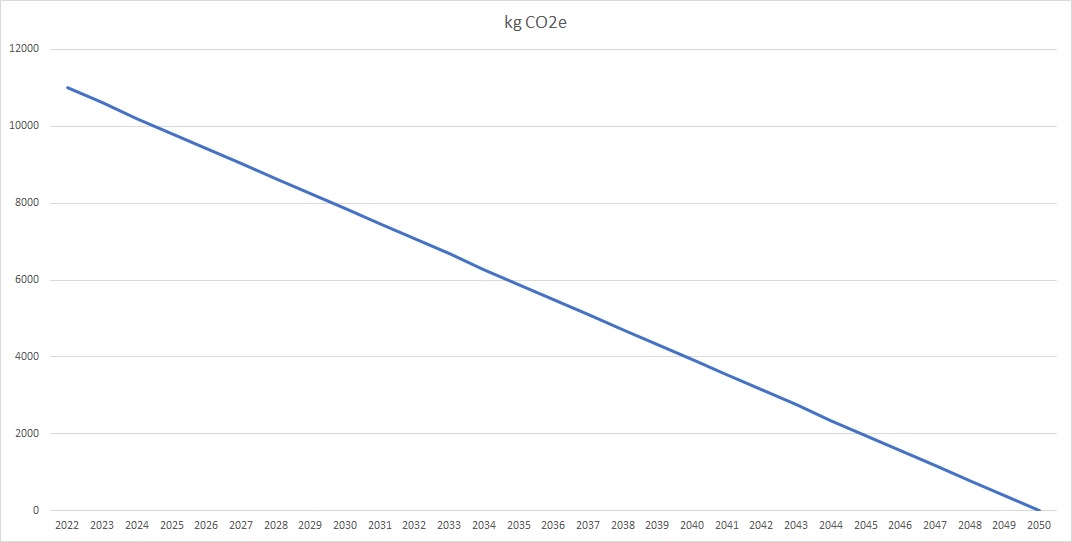Ecoblog
Carbon footprint 2022 and climate target

After two years of COVID-19, 2022 was a return to normal at IHME. As expected, the increase in activity was reflected in the carbon footprint: IHME’s emissions in 2022 were higher than in the two previous years combined. The carbon footprint totalled 18.6 tonnes CO2e, equivalent to the emissions of about two Finns per year. These emissions arose when IHME was promoting the sustainability transition through its commissioned artwork and professional networks. Now it’s time to look forward and set a climate target for the future.
Numbers
IHME operates in the international art field, and 86% of its emissions are linked to travelling. Air travel generated 12.7 tonnes of emissions, other travel and accommodation 3.2 tonnes. These figures come from the Carbon Smart Organisation (Hiilifiksu järjestö) calculator. Using the ICAO calculator, which calculates emissions from fuel alone, the emissions from flights would be four times lower. It’s worth emphasizing that these emissions do not come from random flying around, but from 9 work trips made by artists or curators. Other sources made up 14% of the carbon emissions: about 1.5 tonnes of carbon emissions were generated by heating the office, 0.6 tonnes from services, procurement, and waste management, and less than 0.5 tonnes from IHME commission 2022 and the film screening related to it.
The emissions can be divided between basic operations and commissioned artworks. In 2022, most of the emissions were generated by office maintainance, administration and travel required by curator’s work. The total of these emissions was 8.9 tonnes CO2e. The year’s emissions included 4 tonnes of CO2e for the IHME 2022 commissioned artwork. The core of the Commission was a 10-week online course with a digital carbon footprint of 256 kg CO2e. When the 400 kilos of emissions from accommodation are added to the production emissions, the figures are slightly higher than we previously calculated. As production of an IHME Commission takes about three years, emissions for 2022 also include 5.7 tonnes of CO2e from travel related to the planning and preparation of the next artwork for 2023. Flying made up the largest part of these emissions, too.

Climate target and emission reduction pathway
IHME aims to plan and carry out its activities so that emissions are kept to a minimum. However, methodological guidelines for emission accounting, such as the GHG Protocol, also require emission reduction targets to be set. The Guide to Good Practices in the Voluntary Carbon Market, published by the Ministry of the Environment and Ministry of Agriculture and Forestry in spring 2023, also requires that organizations have a climate target, plus a climate roadmap of measures and a timetable, before making any climate-impact claims.
This is a good time to think about what emission-reduction targets to set for IHME’s activities.
The first question that arises is about the baseline and the target year. Globally, all action should aim to achieve the 1.5°C target set by the Paris Agreement, i.e., to reduce emissions sufficiently to bring global warming below 1.5°C by 2100. This can only be achieved through significant reductions in emissions.
We can, for example, follow the State of Finland, which sets targets and timelines in its Climate Change Act (in Finnish): first, carbon neutrality in 2035, a 60% reduction by 2030, 80% by 2040 and 90-95% by 2050. The baseline here is 1990’s emissions.
The GHG Protocol recommends setting both short-term and long-term targets. Targets can be absolute, and expressed in tonnes of CO2e, or relative (intensity targets), for example, tracking emissions per visitor. The GHG Protocol also says that targets can be set for indirect emissions of an organisation, or for direct emissions only. The GHG Protocol does not give strict instructions for setting the baseline year, even the previous year can be used as a reference year. However, verifiable emissions data has to be available for that year.
Looking at IHME’s history, it would be reasonable to take one of the IHME Festival years as a reference year. The biggest change in the environmental burden of IHME’s activities occurred when IHME gave up running festivals in 2018, along with the accompanying large numbers of international guests and visitors. Assuming that, in 2018, IHME staff took 4 international flights, while 10 festival guests and audience members arrived from London and 10 from Berlin, emissions would amount to more than 26 tonnes. If we draw a straight line from there to zero emissions in 2050, emissions could be 23 tonnes in 2022 and 16 tonnes in 2030, and emissions reductions would still be on track. This is only an indicative estimate, but it shows that a lot has already been done.
If we look at the post-festival period – the three full years of IHME Helsinki’s operations – we get stricter reduction targets. The years 2020 and 2021 were exceptional due to COVID-19 restrictions: in 2020, there were hardly any flights; and, in 2021, two years’ commissioned artworks were carried out with few flights; then, in 2022, a lot of travelling was done that had been postponed during the previous years. If we divide the emissions for the last three years equally between the years, we arrive at 11 tonnes of CO2e. If we aim for zero emissions in 2050, emissions in 2030 should be 7.9 tonnes per year. So far, no IHME Helsinki Commission has exceeded this limit. The emission budget could even include running the office and one return flight to Venice or London.

Things get complicated only if the reference year for IHME’s emission reductions is 1990, the year used by the Finnish State. After all, IHME did not exist then! This brings us to philosophical questions about the limits of responsibility. Another question is whether a conscious organisation like IHME should try to reduce emissions at a faster pace than the common targets, since there are so many organisations that neither know nor care about emissions. That, too, seems an unreasonable demand.
The good news is that we do not have to do anything so difficult. All we need to do is reduce emissions by 3.6% a year – between 400 and 830 kg of CO2e, or the equivalent of one or half a flight, depending on the baseline figure. This appropriately challenges existing practices and encourages considering other options. Concrete emission targets set limits on organisations’ activities in the same way as a financial budget does. Ultimately, emission targets foster creativity within the limits of planetary life-support systems.


